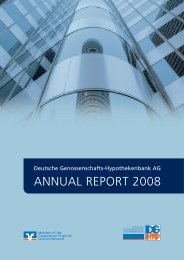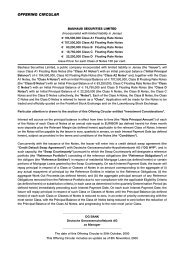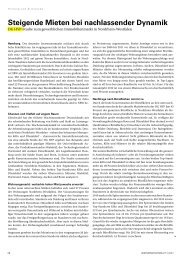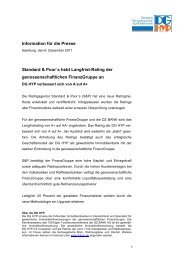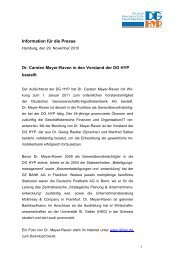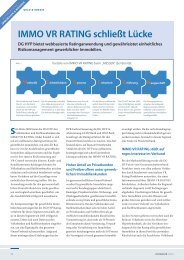Covered Bonds - DG Hyp
Covered Bonds - DG Hyp
Covered Bonds - DG Hyp
You also want an ePaper? Increase the reach of your titles
YUMPU automatically turns print PDFs into web optimized ePapers that Google loves.
<strong>DG</strong> HYP COVERED BONDS – PFANDBRIEFE – QUALITY THE PATH OUT OF THE CRISIS SPECIAL MAY 2009<br />
levels of German government bonds and comparable bonds from government-sector<br />
institutions. The consequence was that the spreads of state development banks and later<br />
also pfandbriefe came under pressure in anticipation of further state-guaranteed issues.<br />
As a result, when LBBW marketed its five-year public-sector pfandbrief in early February it<br />
was obliged to offer a yield spread of 75 basis points over the swap curve. By way of a<br />
comparison: as recently as August – but admittedly before the Lehman bust - Münchner<br />
<strong>Hyp</strong>othekenbank had been able to issue a three-year public-sector pfandbrief at midswap<br />
minus one basis point.<br />
While pfandbriefe initially had to compete with state-guaranteed bank bonds only in the<br />
maturities range up to three years, the maximum permitted term of government-guaranteed<br />
bonds has now been extended to five years. This means that the maturities range beyond<br />
five years is now the only exclusive preserve of pfandbriefe. While two French issuers have<br />
so far got ten-year covered issues away, no pfandbrief issuer has yet dared to test these<br />
waters.<br />
The period during which banks can issue state-guaranteed bonds will expire at the yearend.<br />
Even if the government can theoretically extend this window, the time will eventually<br />
come when banks will only be able to issue unsecured bonds again. Then – if not before -<br />
pfandbriefe will reassert their funding edge and covered bonds will once again be an<br />
increasingly important long-term funding instrument.<br />
The rating agencies factor – methodological changes<br />
The fate of covered bonds as automatic AAA products seems to be sealed. The explanation<br />
lies in the proposals announced by now all three big credit rating agencies to either radically<br />
overhaul or simply modify their methodologies for rating covered bonds. Pfandbriefe are<br />
likely to be negatively impacted too.<br />
� S&P<br />
S&P started the ball rolling back in February. Alongside the innovation that its future<br />
covered bond ratings will be explicitly tied to the issuer rating, an investigation of maturity<br />
mismatches in the two-way cash flows on cover-pool assets and liabilities will form the<br />
cornerstone of S&P’s proposed modified rating methodology. The following is a brief<br />
summary of the key changes:<br />
• A categorisation structure will be developed on the basis of which some<br />
covered bond ratings will be explicitly linked to the issuer’s rating;<br />
• The new methodology will attach more weight to maturity mismatches<br />
between the cover pool‘s cash inflows and outflows;<br />
• Individual covered bond jurisdictions will be scored on the probability of<br />
support they offer;<br />
• S&P will use stricter stress scenarios in future to establish the accurate<br />
market value of cover assets.<br />
S&P has said that if its rating methodology is revised in line with its original proposals, up to<br />
60% of the covered bonds it rates could lose their top-grade rating. Although pfandbriefe are<br />
unlikely to figure amongst the hardest-hit national covered bond segments, both mortgagebacked<br />
and public-sector-loans-backed pfandbriefe are bound to be affected. Now that the<br />
consultation phase has closed at the end of March, it remains to be seen what changes<br />
S&P will eventually make to its rating methodology. Whatever compromises it agrees to, the<br />
<strong>Covered</strong> bonds will regain their core<br />
role as long‐term funding<br />
instruments<br />
S&P planning radical changes to<br />
rating methodology<br />
Up to 60% of covered bonds could<br />
forfeit their best‐of‐breed ratings<br />
9





